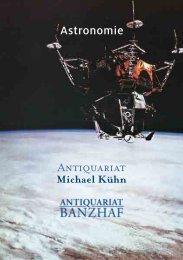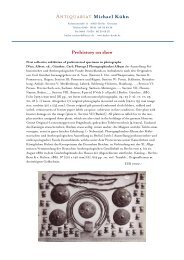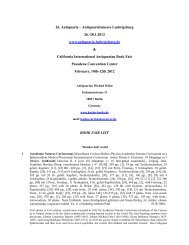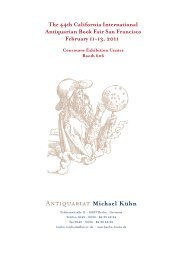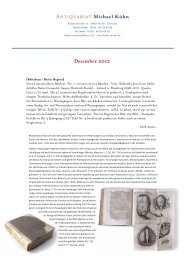List New York Antiquarian Book Fair - Antiquariat - Michael Kühn
List New York Antiquarian Book Fair - Antiquariat - Michael Kühn
List New York Antiquarian Book Fair - Antiquariat - Michael Kühn
You also want an ePaper? Increase the reach of your titles
YUMPU automatically turns print PDFs into web optimized ePapers that Google loves.
Rare physiological work on fresh water fishes and smaller animals in a lake. In four papers Steinbuch discuss<br />
burbot, triturus, polyp (cnidaria), and a similar one. Johann Georg Steinbuch (1770-1818) was lecturer in Erlangen<br />
and physician in Heidenheim, Ulm and Herrenberg. As a young university teacher he was particularly interested<br />
in the brain mechanisms which enable the perception of space and objects.With Justus Kerner he gave a<br />
correct clinical description of botulism. Lit.: Otto Joachim Grüsser. On the history of ideas of efference; Essays<br />
in the history of the physiological sciences (1995), pp. 35 ff. - KVK: Stabi Berlin, München, Tübingen; COPAC:<br />
BL London, Royal Society; OCLC: no copy.<br />
Steinbuch, Johann Georg. Beytrag zur Physiologie der Sinne.- Nürnberg: bey Johann Leonhard<br />
Schrag, 1811. 8° [200 x 120 mm] XVI, 312 pp. Contemporary papercard boards, green<br />
gilt printed label & edges, ownership stamp to title, fine copy. $ 900.-<br />
Important, but forgotten work, on efference copy, reafference and the importance of motor commands in perception.<br />
Association copy: Ex Bibl. Hermann Aubert & Th[eodor] Ziehen.<br />
An empirical work which influenced Wundt, Tourtual, Purkyne & Helmholtz. “In his book Steinbuch presented a<br />
very careful analysis of tactile recognition of objects by the grasping hand. Hereby, he developed the hypothe-sis<br />
that the cerebral mechanisms controlling the movement of the hands interact with the brain with the afferent<br />
signal flow evoked in the mechanoreceptors while the grasping hand is moving across the surface of the object.<br />
The cerebral signals controlling the movement were called ‘Bewegidee’ [motion idea]. According to Steinbuch’s<br />
model, only by the interaction of the ‘Bewegidee’ with the afferent signal flow did object recognition become<br />
possible. After reading Steinbuch’s book Purkyne developed the idea that the ‘Bewegidee’ and the afferent visual<br />
signals interact quantitatively with each other to achieve adequate visual movement perception.” J. E. Purkynĕ<br />
(1787-1869) was one of the leading physiologists in the first half of the 19th century, became the founder<br />
of the "exact subjectivism", and remained during his entire life a very careful observer in psychophysical experiments.<br />
He made moreover many important discoveries in anatomy, neuroanatomy, embryology and pharmacology.-<br />
Lit.. Gary Carl Hatfield. The natural and the normative: theories of spatial perception from Kant to ...<br />
[1990] 130 f.; OCLC: Harvard Countway; NLM Bethesda; NYAM; Univ. Chicago; COPAC: King’s College;<br />
College Physicians; BL London.<br />
Mitosis or Cell division discovered<br />
Strasburger, Eduard. Zellbildung und Zelltheilung. Mit VII Tafeln.- Jena: Hermann Dabis<br />
(Otto Deistungs Buchhandlung), 1875. 8°. IX, [1, blank], [2, "Werthbestimmung"], [2], 256<br />
pp., 7 fold. lith. plates. Contemporary privat cloth, fresh & clean. Leinwandbd. d. Zt., nur<br />
gering berieben, innen durchgängig sauber. Innendeckel mit Ex Libris: Rudolf Virchow (1821<br />
- 1902). $ 1000.-<br />
Rare first edition, uncommon; a book in which he set forth the basic principles of mitosis. In each succeeding<br />
edition he clarified and modified the description of the process until in the third edition (1880) he enunciated one<br />
of the modern laws of plant cytology: that new nuclei can arise only from the division of other nuclei. This copy<br />
with an Ex Libris of Rudolf Virchow, put in after his death. Probably one of his copies or from his library.<br />
Eduard Adolf Strasburger (1844-1912) was one of the most famous botanists of the 19th century. Strasburger is<br />
known as the author of the famous Lehrbuch der Botanik für Hochschulen (Textbook of Botany), which first<br />
appeared in 1894. He was the first to provide an accurate description of the embryonic sac in gymnosperms<br />
(such as conifers) and angiosperms (flowering plants), along with demonstrating double-fertilization in angiosperms.<br />
He came up with one of the modern laws of plant cytology: "<strong>New</strong> cell nuclei can only arise from the<br />
division of other nuclei." and originated the terms cytoplasm and nucleoplasm. Together with Walther Flemming,<br />
and Edouard van Beneden he elucidated chromosome distribution during cell division. His work on the<br />
upward movement of tree sap proved that the process was physical and not physiological.<br />
Bahnbrechendes Werk des Biologen Eduard Strasburger, in dem er bereits in der vorliegenden ersten Ausgabe<br />
seine These der Zellteilung nicht durch Neubildung neuer Kerne, sondern durch Teilung alter Zellkerne anbringt.<br />
In der dritten Ausgabe (1880) des Werks führt er die inzwischen als Grundlehre der modernen Zytologie<br />
anerkannte Theorie weiter aus. Eduard Strasburgers Forschungen beschäftigten sich mit den Befruchtungsvorgängen<br />
bei Moosen, Farnen und Nacktsamern. Sein besonderes Interesse galt der Zellteilung und in diesem<br />
Zusammenhang konnte er bestätigen, daß sich der Zellkern bei der Zellteilung nicht auflöst, sondern im Prozess<br />
der Mitose in zwei Tochterkerne teilt, die an die beiden Tochterzellen weitergegeben werden. Ferner konnte er,<br />
wie zuvor schon Fleming bei tierischen Zellen zeigen, daß sich im Verlaufe der Kernteilung die Chromosomen<br />
der Länge nach spalten. Zu seinen weiteren Entdeckungen gehört die spezies-spezifische Konstanz der Chromosomenzahl<br />
und die Reduktionsteilung (Meiose), die der Bildung von Geschlechtszellen vorangeht. Darüber



